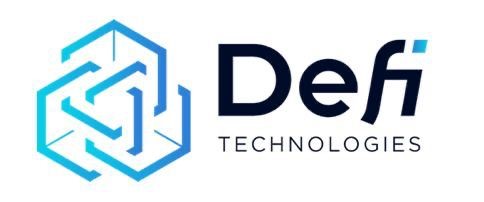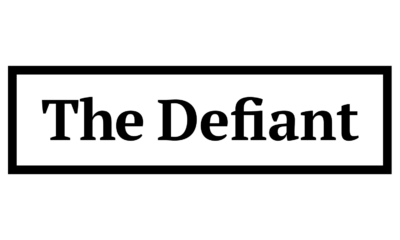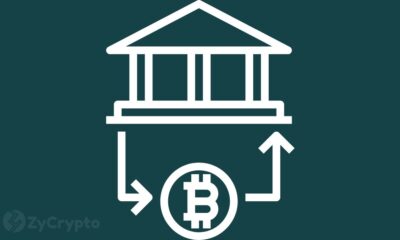DeFi
Valor Inc., filiale de DeFi Technologies, présente le marché mondial

- Lancement de l’ETP Yield-Bearing Bitcoin (BTC) sur la Bourse de Francfort : Valor Inc. et Core Foundation collaborent pour introduire le premier Bitcoin générateur de rendement au monde («BTC”) ETP sur la Bourse de Francfort, précédemment lancé sur le marché nordique de croissance («NGM”) avec des frais de gestion de 1,9 %, offrant aux investisseurs allemands une exposition au Bitcoin avec un rendement de 5,65 %.
- Alimenter Valor Bitcoin Staking (BTC) EUR ETP avec Core Blockchain : Le réseau blockchain Core, alimenté par Bitcoin, constitue la base de Valor Bitcoin Staking (BTC) EUR ETP (ISIN : CH1213604544), fournissant la machine virtuelle Ethereum («EVM”) compatibilité et innovation Mécanisme de consensus Satoshi Plus pour améliorer la sécurité et l’évolutivité.
- Investissement simplifié avec Valor Bitcoin Staking (BTC) EUR ETP : Valor Bitcoin Staking (BTC) EUR ETP rationalise l’investissement Bitcoin en déléguant les Bitcoins aux validateurs Core, le rendement est attribué à la Valeur Nette d’Inventaire («VNI”) sur une base quotidienne. Ce produit innovant garantit un contrôle de garde et une sécurité tout en offrant aux investisseurs un rendement substantiel sans les obliger à vendre ou à échanger leurs avoirs en Bitcoin.
TORONTO, 18 juin 2024 (GLOBE NEWSWIRE) — DeFi Technologies Inc. (le «Entreprise” ou “Technologies DeFi“) (CBOE CA : DEFI) (GR: R9B) (OTC : DEFTF), une société de technologie financière pionnière dans la convergence des marchés de capitaux traditionnels avec le monde de la finance décentralisée («DéFi»), est heureuse d’annoncer que sa filiale Valor Inc. («Valeur“), un émetteur majeur de produits négociés en bourse (“ETP“) qui offrent un accès simplifié aux actifs numériques, a introduit le premier et le seul Bitcoin générateur de rendement au monde («BTC”) ETP aux investisseurs allemands en collaboration avec le Fondation de baseune organisation dédiée au développement du réseau Core blockchain («Chaîne de base“). Cette offre offre aux investisseurs allemands une exposition au Bitcoin avec un rendement annualisé de 5,65% disponible sur la bourse Börse de Francfort. Valor Bitcoin Staking (BTC) EUR ETP a déjà été introduit sur le marché de croissance nordique («NGM») le 10 mai 2024.
Le réseau blockchain Core est une blockchain de couche un alimentée par Bitcoin pour les contrats intelligents compatibles EVM. Avec 50 % de la puissance de hachage minière Bitcoin contribuant à la sécurité de Core Chain en échange du déverrouillage de l’utilitaire Bitcoin et des récompenses, Core Chain est la machine virtuelle Ethereum la plus alignée sur Bitcoin («EVM ») blockchain (BTCfi, jalonnement Bitcoin, etc.).
Négociation du Valor Bitcoin Staking (BTC) EUR ETP (ISIN : CH1213604544) a débuté le 13 juin 2024, avec des frais de gestion de 1,9 %, après ses débuts précédents en Suède. Cet ETP innovant permet aux investisseurs de s’exposer au Bitcoin tout en recevant un rendement annualisé remarquable de 5,65 %, le tout sans avoir besoin de vendre ou d’échanger directement du Bitcoin.
Valor Bitcoin Staking (BTC) L’EUR ETP simplifie l’investissement dans l’actif numérique le plus connu au monde, permettant aux investisseurs de participer plus facilement et plus sûrement à la hausse potentielle du Bitcoin. Le rendement est attribué à la Valeur Liquidative («VNI“) au quotidien, offrant aux investisseurs un rendement sans avoir besoin de vendre ou d’échanger leurs avoirs en Bitcoin.
Valor Bitcoin Staking (BTC) L’EUR ETP génère du rendement en déléguant des Bitcoins à un validateur sur la Core Chain via un jalonnement Bitcoin natif et non dépositaire. Les Bitcoins mis en jeu reçoivent des récompenses de mise sous forme de jetons CORE, qui sont ensuite réinvestis dans le produit. Core Chain, la blockchain sous-jacente, est une blockchain de couche 1 alimentée par Bitcoin, décentralisée, sécurisée et évolutive, compatible avec la machine virtuelle Ethereum (EVM). Il est pris en charge par la preuve de travail de Bitcoin («PoW ») via un mécanisme de consensus unique connu sous le nom de « Satoshi Plus ». Ce mécanisme permet aux mineurs de Bitcoin de déléguer leur PoW («DPW“) aux validateurs principaux sans impact sur leurs futures récompenses Bitcoin, libérant ainsi le potentiel des applications décentralisées sécurisées par Bitcoin.
Malgré le jalonnement de Bitcoin, la sécurité reste sans compromis. Le contrôle de conservation est maintenu pendant que le rendement est généré. Les Bitcoins sont mis en jeu via un type spécifique de transaction Bitcoin native appelé « transaction de mise », qui comprend une période de blocage et des détails de mise en jeu de la chaîne principale tels que le Core Validator et l’adresse de récompense principale. Pendant la période de blocage, les Bitcoins ne peuvent pas être transférés ni réduits. Seul le propriétaire peut transférer les Bitcoins une fois la période de blocage expirée.
“Nous sommes ravis de présenter aux investisseurs allemands le premier et le seul ETP Bitcoin générateur de rendement au monde, offrant une opportunité sans précédent de s’exposer au Bitcoin tout en obtenant un rendement substantiel”, a déclaré Olivier Roussy Newton, PDG de DeFi Technologies.
“Valeur Bitcoin Staking (BTC) L’EUR ETP incarne notre engagement en faveur de l’innovation dans le domaine des actifs numériques, offrant aux investisseurs un moyen transparent et sécurisé de participer au potentiel de croissance de Bitcoin tout en offrant une nouvelle voie d’investissement pour s’engager dans la première crypto-monnaie au monde », a ajouté Marco A. Infuso, directeur Agent des ventes de Valor Inc.
« Core Foundation est ravie de collaborer avec Valor Inc. pour lancer le premier ETP Bitcoin à rendement au monde. Ce produit révolutionnaire permet à BTCfi d’accéder à un public plus large et d’offrir un rendement durable aux détenteurs de Bitcoin. Les investisseurs peuvent désormais gagner du rendement tout en conservant leur exposition au Bitcoin. Ceci est rendu possible par le jalonnement Bitcoin non dépositaire qui contribue à sécuriser la blockchain Core. Core Foundation est fière d’être le premier et le plus fiable écosystème pour alimenter ces nouvelles offres, soulignant la position de Core Chain en tant que blockchain la plus alignée sur Bitcoin », a déclaré Brendon Sedo, contributeur principal.
À propos des technologies DeFi
DeFi Technologies Inc. (CBOE CA : DEFI) (GR: R9B) (OTC : DEFTF) est une société de technologie financière pionnière dans la convergence des marchés de capitaux traditionnels avec le monde de la finance décentralisée (DeFi). En se concentrant spécifiquement sur les technologies Web3 de pointe du secteur, DeFi Technologies vise à fournir un accès généralisé aux investisseurs à l’avenir de la finance. Soutenus par une équipe estimée d’experts possédant une vaste expérience des marchés financiers et des actifs numériques, nous nous engageons à révolutionner la façon dont les individus et les institutions interagissent avec l’écosystème financier en évolution. Rejoignez la communauté numérique de DeFi Technologies sur Linkedin et Twitteret pour plus de détails, visitez https://defi.tech/
À propos de Valor
Valor Inc. et Valor Digital Securities Limited (ensemble, «Valeur») émet des produits négociés en bourse («ETP ») qui permettent aux investisseurs particuliers et institutionnels d’accéder à des actifs numériques comme Bitcoin de manière simple et sécurisée via leur compte bancaire traditionnel. Valor fait partie du secteur d’activité de gestion d’actifs de DeFi Technologies Inc. (CBOE CA : DEFI) (GR: R9B) (OTC : DEFTF).
En plus de leur nouvelle plateforme d’actifs numériques adossés à des supports physiques, qui comprend 1Valour ETP physique neutre en carbone Bitcoin, 1Jalonnement physique Valour Ethereumet Jalonnement physique des ordinateurs Internet 1Valour, Valor propose des ETP d’actifs numériques entièrement couverts avec des frais de gestion faibles à nuls, avec des référencements de produits sur les bourses, banques et plateformes de courtage européennes. La gamme de produits existante de Valour comprend Valor Uniswap (Uni), Cardano (ADA), Pois (POINT), Solana (SOL), Avalanche (AVAX), Cosmos (ATOME), Binance (BNB), Ondulation (XRP), Toncoin (TONNE), ordinateur Internet (PCI), Maillon de chaîne (LIEN) Enjin (ENJ), Valor Bitcoin Staking (BTC), Bitcoin neutre en carbone (BTCN), Panier d’actifs numériques Valor 10 (VDAB10) et ETP Blue Chip pour actifs numériques 1Valour STOXX Bitcoin Suisse avec des frais de gestion faibles. Les produits phares de Valour sont Bitcoin Zero et Ethereum Zero, les premiers produits d’investissement passifs entièrement couverts avec Bitcoin (BTC) et Ethereum (ETH) comme sous-jacents totalement gratuits.
Pour plus d’informations sur Valour, pour vous abonner ou pour recevoir des mises à jour et des informations financières, visitez valeur.com.
À propos de la chaîne principale
Le réseau blockchain Core est une blockchain de couche un alimentée par Bitcoin pour les contrats intelligents compatibles EVM. Avec 50 % de la puissance de hachage du minage de Bitcoin contribuant à la sécurité de Core en échange du déverrouillage de l’utilitaire et des récompenses Bitcoin, Core est la blockchain EVM la plus alignée sur Bitcoin (BTCfi, jalonnement Bitcoin, et plus encore). Cette percée a permis de rassembler une communauté massive de 2,2 millions d’abonnés sur Twitter et de 250 000 membres Discord, ce qui s’est traduit par des millions d’adoptants principaux, plus de 15 millions d’adresses uniques et 230 millions de transactions depuis le lancement du réseau principal en janvier 2023.
Mise en garde concernant les informations prospectives : Ce communiqué de presse contient des « informations prospectives » au sens de la législation canadienne sur les valeurs mobilières applicable. Les informations prospectives comprennent, sans toutefois s’y limiter, le développement futur et les inscriptions d’ETP ; jalonnement de Bitcoin au sein de la Core Chain ; rendement généré par l’ETP Valor Bitcoin Staking (BTC) ; potentiel de croissance du Bitcoin ; l’environnement réglementaire en ce qui concerne la croissance et l’adoption de la finance décentralisée ; la poursuite par DeFi Technologies et ses filiales d’opportunités d’affaires ; et les mérites ou les rendements potentiels de telles opportunités. Les informations prospectives sont soumises à des risques, incertitudes et autres facteurs connus et inconnus qui peuvent faire en sorte que les résultats, le niveau d’activité, la performance ou les réalisations réels de la Société, selon le cas, soient sensiblement différents de ceux exprimés ou sous-entendus par ces informations prospectives. Ces risques, incertitudes et autres facteurs incluent, sans toutefois s’y limiter, l’acceptation des ETP Valor par les bourses et les autorités réglementaires ; la croissance et le développement du secteur DeFi et des crypto-monnaies ; règles et réglementations concernant la DeFi et la crypto-monnaie ; incertitudes générales liées aux affaires, à l’économie, à la concurrence, à la politique et à la société. Bien que la Société ait tenté d’identifier des facteurs importants qui pourraient faire en sorte que les résultats réels diffèrent sensiblement de ceux contenus dans les informations prospectives, il peut y avoir d’autres facteurs qui pourraient faire en sorte que les résultats ne soient pas ceux anticipés, estimés ou prévus. Rien ne garantit que ces informations s’avéreront exactes, car les résultats réels et les événements futurs pourraient différer sensiblement de ceux anticipés dans ces déclarations. Par conséquent, les lecteurs ne doivent pas se fier indûment aux informations prospectives. La Société ne s’engage pas à mettre à jour les informations prospectives, sauf conformément aux lois sur les valeurs mobilières applicables.
LA BOURSE CBOE CANADA DÉCLINE TOUTE RESPONSABILITÉ QUANT À L’ADÉQUATION OU À L’EXACTITUDE DE CE COMMUNIQUÉ
Pour plus d’informations, veuillez contacter :
Olivier Roussy-Newton
Directeur général
ir@defi.tech
(323) 537-7681
Une photo accompagnant cette annonce est disponible sur https://www.globenewswire.com/NewsRoom/AttachmentNg/90420f53-24d6-4834-bf04-0c73fe433c92

DeFi
Haust Network Partners with Gateway to Connect to AggLayer

Dubai, United Arab Emirates, August 1, 2024, Chainwire
Consumer adoption of cryptocurrencies is a snowball that is accelerating by the day. More and more people around the world are clamoring for access to DeFi. However, the user interface and user experience of cryptocurrencies still lag behind their fundamental utility, and users lack the simple and secure access they need to truly on-chain products.
Haust Network is a network and suite of products focused on changing this paradigm and bringing DeFi to the masses. To achieve this goal, Haust Network has announced its far-reaching partnership with bridgeseasoned veterans in rapidly delivering revolutionary blockchain utilities for projects. The Gateway team empowers blockchain developers to build DAOs, NFT platforms, payment services, and more. They drive adoption of crypto primitives for individuals and institutions around the world by helping everyone build their on-chain presence.
Gateway specializes in connecting sovereign blockchains to the Aggregation Layer (AggLayer). The AggLayer is a single unified contract that powers the Ethereum bridge of many disparate blockchains, allowing them all to connect to a single unified liquidity pool. The AggLayer abstracts away the complexities of cross-chain DeFi, making tedious multi-chain transactions as easy for the end user as a single click. It’s all about creating access to DeFi, and with Polygon’s technology and the help of Gateways, Haust is doing just that.
As part of their partnership, Gateway will build an advanced zkEVM blockchain for Haust Network, leveraging its extensive experience to deploy ultra-fast sovereign applications with unmatched security, and enabling Haust Network to deliver its products to its audience.
The recently announced launch of the Haust Wallet is a Telegram mini-app that provides users with access to DeFi directly through the Telegram interface. Users who deposit funds into the wallet will have access to all standard send/receive services and generate an automatic yield on their funds. The yield is generated by Haust Network’s interconnected network of smart contracts, Haustoria, which provides automated and passive DeFi yielding.
As part of this partnership, the Haust Network development team will work closely with Gateway developers to launch Haust Network. Gateway is an implementation provider for Polygon CDK and zkEVM technology, which the Haust wallet will leverage to deliver advanced DeFi tools directly to the wallet users’ fingertips. Haust’s partnership with Gateway comes shortly after the announcement of a high-profile alliance with the Polygon community. Together, the three will work to build Haust Network and connect its products to the AggLayer.
About Haust Network
Haust Network is an application-based absolute liquidity network and will be built to be compatible with the Ethereum Virtual Machine (EVM). Haust aims to provide native yield to all users’ assets. In Telegram’s Haust Wallet, users can spend and collect their cryptocurrencies in one easy place, at the same time. Haust operates its network of self-balancing smart contracts that interact across multiple blockchains and then efficiently funnel what has been generated to Haust users.
About Gateway
bridge is a leading white-label blockchain provider that offers no-code protocol deployment. Users can launch custom blockchains in just ten minutes. They are an implementation provider for Polygon CDK and have already helped projects like Wirex, Gnosis Pay, and PalmNFT bring new utility to the crypto landscape.
About Polygon Labs
Polygon Laboratories Polygon Labs is a software development company building and developing a network of aggregated blockchains via the AggLayer, secured by Ethereum. As a public infrastructure, the AggLayer will aggregate the user bases and liquidity of any connected chain, and leverage Ethereum as the settlement layer. Polygon Labs has also contributed to the core development of several widely adopted scaling protocols and tools for launching blockchains, including Polygon PoS, Polygon zkEVM, and Polygon Miden, which is currently under development, as well as the Polygon CDK.
Contact
Lana Kovalski
haustnetwork@gmail.com
DeFi
Ethena downplays danger of letting traders use USDe to back risky bets – DL News

- Ethena and ByBit will allow derivatives traders to use USDe as collateral.
- There is a risk in letting traders use an asset partially backed by derivatives to place more bets.
Ethena has downplayed the dangers of a new feature, which will allow traders to put up its synthetic dollar USDe as collateral when trading derivatives, which are risky bets on the prices of crypto assets.
While allowing users to underwrite their trades with yield-bearing USDe is an attractive prospect, Ethena said there is potential risk in letting traders use an asset partially backed by derivatives to place even more derivatives bets.
“We have taken this risk into account and that is why Ethena operates across more than five different sites,” said Conor Ryder, head of research at Ethena Labs. DL News.
The move comes as competition in the stablecoin sector intensifies.
In recent weeks, PayPal grown up the amount of its stablecoin PYUSD in circulation 96%, while the MakerDAO cooperative plans a rebrandingaiming to increase the supply of its DAI stablecoin to 100 billion.
US dollar growth stagnates
It comes as Ethena has lost momentum after its blockbuster launch in December.
In early July, USDe reached a record level of 3.6 billion in circulation.
That figure has now fallen by 11% to around 3.2 billion.
Join the community to receive our latest stories and updates
New uses for USDe could boost demand for Ethena’s products.
This is where the new plan, announcement Tuesday with ByBit, one of its partner exchanges, is coming.
Ethena users create USDe by depositing Bitcoin or Ether into the protocol.
Ethena then covers these deposits with short positions – bearish bets – on the corresponding asset.
This creates a stable support for USDe, unaffected by price fluctuations in Bitcoin or Ether.
Mitigate risks
While using USDe as collateral for derivatives trading is proving popular, it is unclear what the effects will be if the cryptocurrency market experiences major fluctuations.
Using derivatives as collateral to place more bets has already had disastrous effects.
In June 2022, Lido’s liquid staking token stETH broke its peg to Ether following the fallout from the Terra collapse.
Many traders who used looping leverage to increase their stETH staking yields were liquidated, creating a cascade that caused the price of Ether to drop by more than 43%.
Ethena Labs founder Guy Young said: DL News His office and his partners have taken many precautions.
Ethena spreads bearish bets supporting the USDe across the five exchanges it partners with.
According to Ethena, 48% of short positions supporting USDe are on Binance, 23% on ByBit, 20% on OKX, 5% on Deribit, and 1% on Bitget. website.
In doing so, Ethena aims to minimize the impact of an unforeseen event on a stock market.
The same theory applies to the distribution of risks across different supporting assets.
Fifty percent of USDe is backed by Bitcoin, 30% by Ether, 11% by Ether liquid staking tokens, and 8% by Tether’s USDT stablecoin.
Previous reviews
Ethena has already been criticised regarding the risks associated with USDe.
Some have compared USDe to TerraUSD, an undercollateralized stablecoin that collapsed in 2022.
“It’s not a good design for long-term stability,” said Austin Campbell, an assistant professor at Columbia Business School. said as the USDe launch approaches.
Young replied to critics, saying the industry needs to be more diligent and careful when “marketing products to users who might not understand them as well as we do.”
Ethena has since added a disclaimer on its website stating that USDe is not the same as a fiat stablecoin like USDC or USDT.
“This means that the risks involved are inherently different,” the project says on its website.
Tim Craig is DL News DeFi correspondent based in Edinburgh. Feel free to share your tips with us at tim@dlnews.com.
DeFi
Cryptocurrency and defi firms lost $266 million to hackers in July

In July 2024, the cryptocurrency industry suffered a series of devastating attacks, resulting in losses amounting to approximately $266 million.
Blockchain Research Firm Peck Shield revealed in an X post On August 1, attacks on decentralized protocols in July reached $266 million, a 51% increase from $176 million reported in June.
The most significant breach last month involved WazirX, one of India’s largest cryptocurrency exchanges, which lost $230 million in what appears to be a highly sophisticated attack by North Korean hackers. The attack was a major blow to the stock market, leading to a break in withdrawals. Subsequently, WazirX launched a program in order to recover the funds.
Another notable incident involved Compound Finance, a decentralized lending protocol, which suffered a governance attack by a group known as the “Golden Boys,” who passed a proposal who allocated 499,000 COMP tokens – valued at $24 million – to a vault under their control.
The cross-chain liquidity aggregation protocol LI.FI also fell victim On July 16, a hack resulted in losses of $9.73 million. Additionally, Bittensor, a decentralized machine learning network, was one of the first protocols to suffer an exploit last month, loming $8 million on July 3 due to an attack targeting its staking mechanism.
Meanwhile, Rho Markets, a lending protocol, suffered a $7.6 million breach. However, in an interesting twist, the exploiters research to return the stolen funds, claiming the incident was not a hack.
July 31, reports The Terra blockchain protocol was also hacked, resulting in a loss of $6.8 million across multiple cryptocurrencies. As crypto.news reported, the attack exploited a reentrancy vulnerability that had been identified a few months ago.
Dough Finance, a liquidity protocol, lost $1.8 million in Ethereum (ETH) and USD Coin (USDC) to a flash loan attack on July 12. Similarly, Minterest, a lending and borrowing protocol, saw a loss of $1.4 million due to exchange rate manipulation in one of its markets.
Decentralized staking platform MonoSwap also reported a loss of $1.3 million following an attack that allowed the perpetrators to withdraw the liquidity staked on the protocol. Finally, Delta Prime, another decentralized finance platform, suffered a $1 million breach, although $900,000 of the stolen funds was later recovered.
DeFi
The Rise of Bitcoin DeFi: Then and Now

The convergence of Bitcoin’s robust security and Layer 2 scaling solutions has catalyzed the emergence of a vibrant DeFi ecosystem.
By expanding Bitcoin’s utility beyond simple peer-to-peer payments, these advancements have opened up a new frontier of financial possibilities, allowing users to participate in decentralized lending, trading, and other complex smart contract operations on Bitcoin.
Read on to learn about the rise of Bitcoin-based decentralized finance and how the space has expanded to accommodate a new generation of native assets and features.
Note: If you want to learn candlesticks and chart trading from scratch, this is the best book available on Amazon! Get the book now!
What is DeFi?
Decentralized finance (DeFi) represents a paradigm shift in financial services, offering internet-based financial products such as trading, lending, and borrowing through the use of decentralized public blockchains.
By implementing blockchains, smart contracts, and digital assets, DeFi protocols provide financial services through a decentralized ecosystem, where participants do not have to deal with intermediaries when transacting.
What is Bitcoin DeFi?
The inherent limitations of the Bitcoin mainchain in supporting the intricacies of decentralized finance have created the need to develop smart contract-based Layer 2 solutions.
Additionally, the advent of the Ordinals protocol in 2023, which facilitated the emergence of fungible token standards such as BRC-20 and Runes, catalyzed the growth of DeFi on the Bitcoin blockchain.
This expansion in protocol diversity has broadened the applications of the world’s leading cryptocurrency network beyond the core base-layer use cases around value preservation and transactional capabilities.
Therefore, Bitcoin DeFi has become a nascent sector within the digital asset market, after previously being a missing essential part of the Bitcoin ecosystem.
Bitcoin DeFi in its early days
Integrating decentralized finance (DeFi) concepts into the Bitcoin ecosystem has been a journey of innovation and perseverance. Early attempts to bridge the gap between Bitcoin’s fundamental simplicity and DeFi’s complexities have spawned pioneering projects that, while laying essential foundations, have also encountered significant obstacles.
Colored coins
Colored coins represented an early foray into tokenizing real-world assets on the Bitcoin blockchain. By leveraging the existing network to track ownership of assets ranging from stocks to real estate, this approach highlighted Bitcoin’s potential as a platform beyond digital currency. However, scalability and practical implementation challenges have limited its widespread adoption.
Counterpart
Building on the colored coins, Counterparty has become a platform for creating and trading digital assets, including non-fungible tokens (NFTs), on Bitcoin.
The introduction of popular projects like Rare Pepe NFTs has demonstrated the growing appeal of digital collectibles. However, constraints around user experience and network efficiency have hampered its full potential.
These early experiments, while not fully realizing their ambitions, served as valuable stepping stones, informing Bitcoin DeFi’s subsequent developments. Their challenges highlighted the need for more sophisticated infrastructure and protocols to harness the full potential of decentralized finance on the Bitcoin network.
Bitcoin DeFi Today
Today, building DeFi applications on Bitcoin is primarily done in the realm of Layer 2 (L2) networks. This architectural choice is motivated by the limitations of Bitcoin’s base layer in supporting complex programmable smart contracts.
Bitcoin’s original design prioritized security and decentralization over programmability, making it difficult to develop sophisticated DeFi protocols directly on its blockchain. However, the recent emergence of protocols like Ordinals, BRC-20, and Runes, while not DeFi in their own right, has sparked possibilities for future DeFi-like applications on the main chain.
In contrast, L2 solutions offer a scalable and programmable environment built on Bitcoin, enabling the creation of various DeFi products.
By expanding Bitcoin’s capabilities without compromising its core principles, L2s have become the preferred platform for developers looking to build DeFi applications that encompass trading, lending, staking, and more.
Leading L2 networks such as Lightning Network, Rootstock, Stacks, and Build on Bitcoin provide the infrastructure for these efforts. Some of these L2s have even introduced their own native tokens to the network, further expanding Bitcoin’s DeFi ecosystem.
Essentially, while Bitcoin’s core layer presents challenges for DeFi development, its security and decentralization have provided a foundational layer for the innovative L2 landscape to thrive.
Bitcoin Layer 2 offers a promising path to building a robust and thriving Bitcoin-based DeFi ecosystem that offers trading, staking, lending, and borrowing. All you need is a DeFi Wallet like Xverse to access the new world of decentralized financial services secured by Bitcoin.
Conclusion
The integration of DeFi principles into the Bitcoin ecosystem, primarily facilitated by Layer 2 solutions, marks a significant evolution in the digital asset landscape.
Building on the foundational work of pioneers like Colored Coins and Counterparty, the industry has evolved into more sophisticated platforms like Rootstock, Stacks, and Build on Bitcoin to create a thriving Bitcoin-powered DeFi ecosystem.
Advertisement
-

 News1 year ago
News1 year agoBitcoin soars above $63,000 as money flows into new US investment products
-

 DeFi1 year ago
DeFi1 year agoEthena downplays danger of letting traders use USDe to back risky bets – DL News
-

 News1 year ago
News1 year agoFRA Strengthens Cryptocurrency Practice with New Director Thomas Hyun
-

 DeFi1 year ago
DeFi1 year agoZodialtd.com to revolutionize derivatives trading with WEB3 technology
-

 Markets1 year ago
Markets1 year agoBitcoin Fails to Recover from Dovish FOMC Meeting: Why?
-

 DeFi1 year ago
DeFi1 year ago👀 Lido prepares its response to the recovery boom
-

 Markets1 year ago
Markets1 year agoWhale Investments in Bitcoin Reached $100 Billion in 2024, Fueling Crazy Investor Optimism ⋆ ZyCrypto
-

 Markets1 year ago
Markets1 year agoWhy Bitcoin’s price of $100,000 could be closer than ever ⋆ ZyCrypto
-

 DeFi1 year ago
DeFi1 year agoPancakeSwap integrates Zyfi for transparent, gas-free DeFi
-

 Markets1 year ago
Markets1 year agoWhales are targeting these altcoins to make major gains during the bull market 🐋💸
-

 DeFi1 year ago
DeFi1 year ago🏴☠️ Pump.Fun operated by Insider Exploit
-

 News1 year ago
News1 year agoHow to make $1 million with crypto in just 1 year 💸📈














